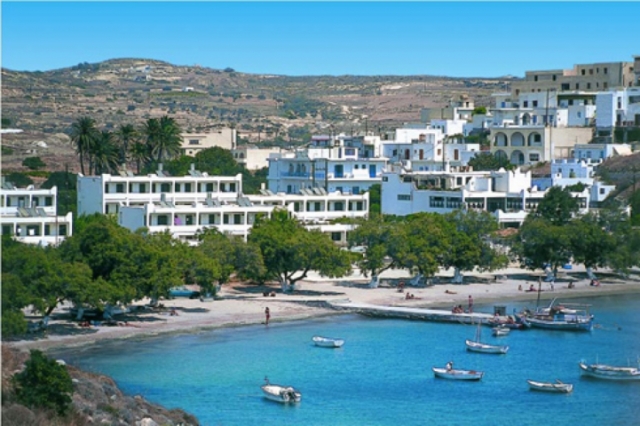Press here.
Places near Beach
From Chivadolimni following the central road you get to Aghia Marina. Then, descending on the earth-road towards the sea there is a quiet blue beach viewing the entire port. The “Rivari” lagoon is located nearby.
Assumption of Virgin Mary or Aghios Haralampos
This church is located behind Adamantas port, on the village’s highest point. It was built by Cretan refugees in 1870 and it was named after the church of the Assumption of the Virgin Mary of Portaitissa (old cathedral of the island) and the church next to it, Saint Haralampos. These two churches were situated in the island’s old capital, Zefyria, from where the woodcut icon screen and the old icons of this magnificent church were transferred.
The church’s architecture is that of a three-aisled arched with a dome church and its dome is built on the semi-cylindrical vault of the middle aisle. In the churchyard you can admire a mosaic by Ioannis Kavroudakis, made of Melian pebbles, representing an eagle flying eastwards. On its lower part, between the dolphins, there is the emblem of the community of Adamantas .
In the church of the Assumption of the Virgin Mary or church of Saint Haralampos (the locals call it “Saint Haralampos church”), you will see icons of Cretan-byzantine art from the destroyed churches of Zefyria, the woodcut icon screen and the precious icon of the Virgin Mary, covered with sheets of silver.
This modern seaside village is situated inside the bay of the island, which is one of the biggest and safest natural bays of the Mediterranean sea, and it constitutes the largest tourist center of Milos.
Adamantas is its main port and the first view to look upon when approached by ship.
Built on the north side of the bay, Adamantas or ‘’Alamanto” as it used to be called, has been inhabited since 1824. It was built by Cretan refugees expelled from Sfakia, who came to Milos after their failed and bloody revolution against the Turks. Nowadays, the village numbers around 1100 inhabitants.
This seaside island town is composed of small snow-white houses with small yards decorated with flowers and narrow quite lanes which altogether compose a picture of excellent Cycladic beauty. The village of Adamantas throbs with life in summertime. In this village you can combine relaxation and calmness with night life and entertainment, whereas at the same time everything you need for comfortable and pleasant vacations is provided to you: [there are] cafes, restaurants, ouzeries, pizzerias, grill-houses, fast-foods serving souvlaki, a bar, a club, shopping centers, supermarkets, banks, the port authority, the customs, a health center, a pharmacy, a dental clinic, a newsstand for Greek and international press, etc. Here, the island’s night life is intense with bars playing various kinds of music that speed up the rhythms and the entertainment tempo till the very break of dawn.
On the port’s left side you can find the parking lot and then the Lagkada quarter with the Lagkada beach, whereas on the port’s right side the main coastal road stretches out leading to the village’s central square where the bus stop lies, and the taxis await you. On the one side of this coastal road, there is a long tiled pavement, cafeterias, restaurants and tourist shops as well as the municipal Hot Springs of Lakkos, whereas on its left side stand the relatively new port facilities which combined with the safety of the natural port, make Adamantas suitable for yachting activities. (From that point also the trips with boats and touring yachts set out reaching for the inaccessible beaches of the island and also for the tour around Milos and Kimolos).
If you desire to swim, Adamantas can offer that to you, too. Within a short distance and accessible without the use of any means of transportation, lie the beaches of Lagkada (500m from the center of Adamantas) and the beaches of Papikinos (1km away from Adamantas).
Finally, the sights of Adamantas include also : the church of The Assumption of the Virgin, the catholic church of Saint Nikolaos, the Mineral Museum and the Church Museum where the one thousand year old church of The Holy Trinity is housed.
It is the biggest beach of the island with a snow-white coast and navy blue shallow waters.
There, you will find an organized camping and the beach is accessible by bus, too. It was named after the lake that exists in the opposite side which is full of clams.
Achivadolimni or Chivadolimni is divided into two beaches: the first is more quiet and isolated, whereas the second is more frequent, organized and there are a beach-bar and restaurants. The beach is the ideal choice for the lovers of surfing and kite-surfing.
The nearest beach to the port of Adamantas with clear waters and many tamarisks for natural shade. The big beach is yellow-white and it is organized.
Very close to Adamantas port, the church of The Holy Trinity is located, where the Church Museum is housed.
This church, which is over a thousand years old, is characterized as “crossed-shaped three-aisled basilica with troulokamara (arched-dome)”, since it is made of three aisles on which the dome rises vertically having the shape as the temple. This type of church is very rare (there is only one more such church, in Peloponnesus, in Levidi, Arcadia) and it is an interested architectural monument.
Initially it was made so as to serve as a monastery dedicated to the Virgin Mary of Theofani, but in 1839 it was purchased by Cretan refugees and they turned it into their village’s church. The edges and the arches of its bell-tower are influenced by the gothic patterns, whereas the lintels and the pilasters are decorated with traditional sculptures and religious patterns. In the yard, at the church’s entrance, you will see two mosaics, creations of the local artist Giagos Kavroudakis. These two colorful mosaics are dated from 1937; one of them depicts a dragon in the shape of Milos, whereas the other depicts the battle of the good against the evil.
Ever since 2000 the Church Museum of Milos has been housed in the church of The Holy Trinity, a museum where you are given the chance to admire a great part of the Melian artistic tradition and heritage as well as of the Melian hagiographic tradition. More specifically, you can see icons dated from the 14th century (such as a rare deposition from the cross), works of the Cretan school, works by Emmanuel Skordilis and Antonios Skordilis and Cretan painters, epitaphs and woodcut lecterns, 17th century iconostases, the bishop’s throne, the icon screens, silver chalices, incensories, golden offerings, rings, necklaces, earrings and other exhibits of important artistic value.
Aghia Marina (Saint Marina)
On the way to Halakas, just before you get to the beach of Fatourena, you will reach the monastery of Saint Marina. This monastery was in operation from around 1650 to 1830 and it is one of the 13 monasteries the French traveler Tournieyef visited while it was still in operation and which he mentions with admiration in his travel accounts. (Tournieyef visited Milos in 1700).
Το Μουσείο άνοιξε τον Σεπτέμβρη του 2008 και στεγάζεται πάνω από το λιμάνι του Αδάμαντα, στο κτίριο της παλιάς Κοινότητας του νησιού.
Δημιουργήθηκε από τις προσπάθειες του γιατρού Πέτρου Αρμένη να συγκεντρώσει πλήθος εκθεμάτων σχετικών με τη ναυτική δραστηριότητα στη Μήλο. Τα εκθέματα ξεκινούν από την προϊστορική εποχή, με εργαλεία από οψιδιανό, προχωρούν στην ναυμαχία της Σαλαμίνας και καταλήγουν στα νεότερα χρόνια.
Στο Ναυτικό Μουσείο έχετε την ευκαιρία να δείτε επίσης σπάνιους χάρτες, από τα χέρια ειδικών χαρτογράφων, και τη φημισμένη ξυλόβαρκα «Ειρήνη».
Southwest of The Holy Trinity church (Church Museum) stands the Catholic church of Saint Nikolaos. It was built in 1827 by the French vice-consul Louis Brest and on its floor there are three tombs covered with marble tables with inscriptions in English, French and Latin.










